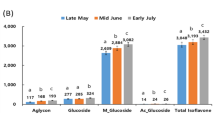Abstract
This study reports the isoflavone contents of 210 soybean cultivars grown in South Dakota and explores possible relations between isoflavone contents and agronomic characteristics. Total isoflavone contents (normalized) ranged from 1161 to 2743 μg/g. A number of agronomic characteristics were documented for each variety including maturity group, hilum color, disease resistance, seed weight, yield, maturity (in days), and plant height. Varieties in maturity group I had significantly higher total isoflavones when compared to maturity group 0. Hilum color was related to differences in genistin, daidzein, and genistein content. No differences in isoflavone content were observed based on disease resistance profiles. Genistein content was found to be negatively correlated with yield, days of maturity, and plant height. Weak but significant correlations also existed between these agronomic characteristics and other isoflavones.
Similar content being viewed by others
References
Barnes, S., C. Grubbs, K.D. Setchell, and J. Carlson, Soybeans Inhibit Mammary Tumors in Models of Breast Cancer, Prog. Clin. Biol. Res. 347:239–253 (1990).
Potter, S.M., J. Baum, P. Surya, and J.W. Erdman, Effects of Soy Protein and Isoflavones on Plasma Lipid Profiles in Postmenopausal Women, Second International Symposium on the Role of Soy in Preventing and Treating Chronic Disease, edited by M. Messina, Brussels, Belgium, 1996, pp. 22.
Wang, H.J., and P.A. Murphy, Isoflavone Composition of American and Japanese Soybeans in Iowa: Effects of Variety, Crop Year, and Location, J. Agric. Food. Chem. 42:1674–1677 (1994).
Tsukamoto, C., S. Shimadu, K. Igita, S. Kudou, M. Kokuun, K. Okuibo, and K. Kitamura, Factors Affecting Isoflavone Content in Soybean Seeds: Changes in Isoflavones, Saponins, and Composition of Fatty Acids at Different Temperatures During Seed Development, Ibid. 43:1184–1192 (1995).
Eldridge, A.C., and W.F. Kwolek, Soybean Isoflavones: Effect of Environment and Variety on Composition, Ibid. 31:394–396 (1983).
Graham, T.L., Flavonoid and Isoflavonoid Distribution in Developing Soybean Seedling Tissues and in Seed and Root Exudates, Plant Physiol. 95:594–603 (1991).
Buttery, B.R., and R.I. Buzzell, Varietal Differences in Leaf Flavonoids of Soybeans, Crop. Sci. 13:103–106 (1973).
Murali, N.S., and A.H. Teramura, Effects of Ultraviolet-B Irradiance on Soybean. VI. Influence of Phosphorus Nutrition on Growth and Flavonoid Content, Physiol. Plant. 63:413–416 (1985).
Hall, R.G., and P.D. Evenson, Soybeans: 1995 Variety Recommendations (1994 Crop Performance Test Results, SDSU EC 775, South Dakota State University, Brookings, South Dakota, 1995.
Wang, H.J., and P.A. Murphy, Isoflavone Content in Commercial Soybean Foods, J. Agric. Food Chem. 42:1666–1673 (1994).
Kuduo, S., Y. Fleury, D. Welti, D. Magnolato, T. Uchida, K. Kitamura, and K. Okubo, Manonyl Isoflavone Glycosides in Soybean Seeds (Glycine max L. Merrill), Agric. Biol. Chem. 55: 2227–2233 (1991).
Association of Official Analytical Chemists, Official Methods of Analysis of the Association of Official Analytical Chemists, 15th edn., Arlington, 1990.
SAS Institute, Inc., SAS/STAT Guide for Personal Computers, 6th edn., Cary, North Carolina, 1987.
Fleury, Y., D.H. Welti, G. Philippossian, and D. Magnolato, Soybean (malonyl) Isoflavones: Characterization and Antioxidant Properties, ACS Symposium Series 507:98–113 (1992).
Naim, M., B. Gestetner, S. Zilkah, Y. Birk, and A. Bondi, Soybean Isoflavones, Characterization, Determination, and Antifungal Activity, J. Agric. Food. Chem. 22:806–810 (1974).
Author information
Authors and Affiliations
Corresponding author
About this article
Cite this article
Wang, C., Sherrard, M., Pagadala, S. et al. Isoflavone content among maturity group 0 to II soybeans. J Amer Oil Chem Soc 77, 483–487 (2000). https://doi.org/10.1007/s11746-000-0077-6
Received:
Accepted:
Issue Date:
DOI: https://doi.org/10.1007/s11746-000-0077-6



